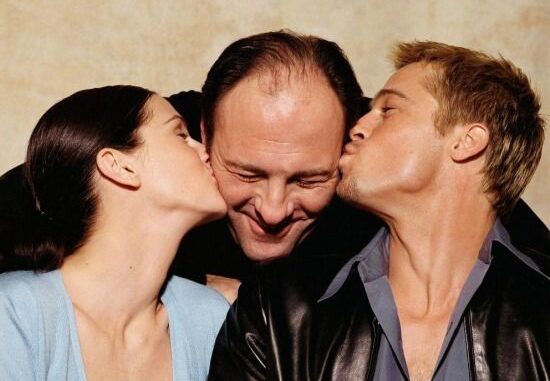
The 2007 finale of The Sopranos left audiences with one of the most debated questions in television history: Did Tony Soprano live or die in that final, suspenseful diner scene? Over a decade later, creator David Chase has shed new light on this cryptic ending, subtly hinting at the possible fate of one of television’s most iconic characters.
The Infamous Final Scene: A Masterpiece of Ambiguity
The last moments of The Sopranos are unforgettable. In the closing scene, Tony Soprano (James Gandolfini) sits with his family at Holsten’s Diner, enjoying an ordinary meal. As Journey’s “Don’t Stop Believin'” plays, the camera cuts between Tony’s perspective and various patrons entering the diner. The tension builds as Tony glances up one last time, and then, in a jarring instant, the screen cuts to black. For 11 seconds, viewers sit in darkness, left to interpret the meaning for themselves.
The finale instantly sparked intense debate. Was the abrupt blackout a symbol of Tony’s demise? Or was it a representation of Tony’s paranoia and the ever-present danger in his life? Chase has offered only cryptic hints over the years, leaving fans to fill in the blanks.
David Chase Breaks His Silence
In recent years, Chase has revealed tantalizing details about the final episode, although he stops short of a definitive answer. In one interview, he referred to the finale as a “death scene,” fueling speculation that Tony’s life did indeed end in that last moment. However, he later clarified that he never intended to create a simple murder scene.
This year, Chase added another layer of mystery by discussing his original idea for the series finale. He mentioned that he envisioned the final shot taking place with Tony in his car, cut off abruptly—an idea he later reworked into the scene at Holsten’s. This revelation has led some fans to believe that the cut-to-black was always meant to symbolize an abrupt and violent end to Tony’s life, consistent with the notion that death can come suddenly, without warning.
Analyzing Chase’s Hints and Symbolism
The final episode, titled “Made in America,” is packed with potential foreshadowing that could suggest Tony’s end. Throughout the series, Tony’s life in organized crime is depicted as a ticking time bomb, with betrayal, violence, and death constantly hovering over him. In the finale, a mysterious man in a Members Only jacket catches Tony’s eye—possibly representing a hitman sent to carry out revenge. The subtle nod to The Godfather restaurant scenes suggests that Chase intentionally layered these final moments with cinematic cues associated with betrayal and assassination.
Another theory posits that the blackout symbolizes Tony’s perspective—if he were killed, he wouldn’t be aware of it, and so neither would the audience. This aligns with an earlier statement Chase made in an interview where he mused on how people experience their own deaths, suggesting that “you wouldn’t hear it coming.” In that context, the cut-to-black becomes a reflection of Tony’s sudden, silent end.
Journey’s “Don’t Stop Believin'”—An Irony of Hope?
The choice of Journey’s “Don’t Stop Believin’” as the soundtrack to the final scene adds yet another layer of irony. The song’s hopeful lyrics contrast sharply with the ominous atmosphere of the diner, with its message of resilience and optimism juxtaposed against Tony’s perilous situation. Some fans interpret the song as Chase’s way of saying that the story isn’t about whether Tony lives or dies—it’s about his enduring legacy as a complex, morally ambiguous character who embodies the contradictions of American life.
Why Chase’s Ambiguity Matters
David Chase’s decision to leave Tony’s fate ambiguous may be the most powerful statement of all. In a world that craves closure, Chase challenges viewers to confront the uncertainties of life. The Sopranos has always been a show that subverts expectations, portraying the mob boss not as a glorified antihero, but as a deeply flawed individual whose lifestyle is riddled with emotional scars and moral compromises.
Leaving Tony’s fate unresolved might also reflect Chase’s disdain for tidy conclusions, especially in a story that explores the moral gray areas of power, loyalty, and identity. By refusing to provide answers, Chase leaves the viewer in a space of reflection, as if to say that Tony’s life, much like the lives of real people, does not neatly resolve.
A Legacy of Debate
David Chase’s hints only add to the legacy of The Sopranos as a groundbreaking show that redefined television storytelling. Fans continue to debate, analyze, and revisit the finale, finding new interpretations each time. For some, the ambiguity serves as a reminder of the constant threat in Tony’s world—of violence, betrayal, and death. For others, it is an open-ended tale, one that mirrors the unresolved questions of life itself.
The Final Verdict: Is There One?
Chase may never give a definitive answer, but perhaps that’s exactly the point. As Tony himself once said, “There’s two kinds of people in the world: those who want answers and those who don’t.” Whether Tony Soprano lived or died that night at Holsten’s is ultimately less important than the impact of the show and its place in television history.
In the end, David Chase’s masterpiece encourages fans to keep the debate alive, as timeless and tantalizing as ever. The real brilliance of The Sopranos lies not in the answer to Tony’s fate but in the questions it forces us to ask about life, death, and everything in between.
